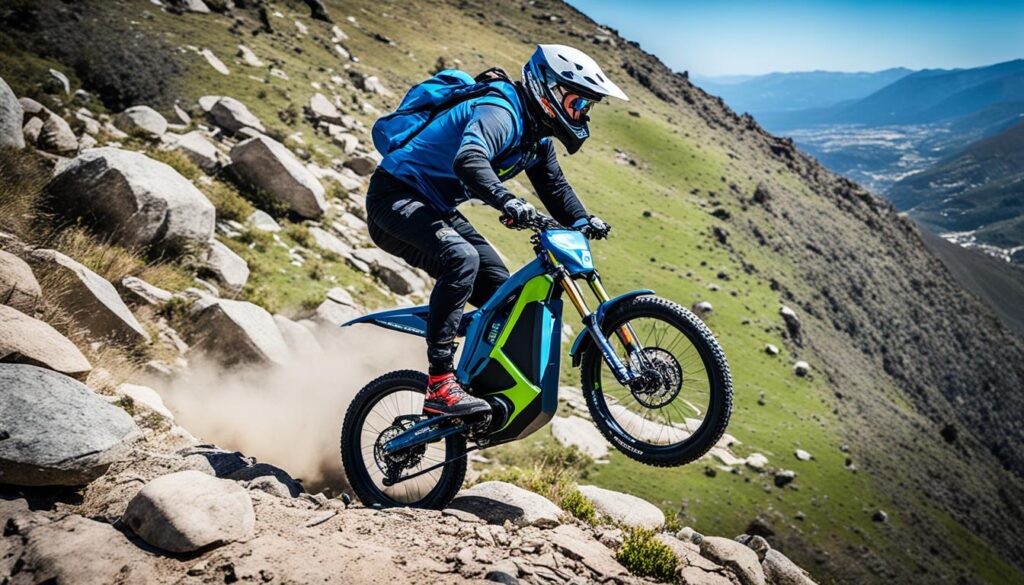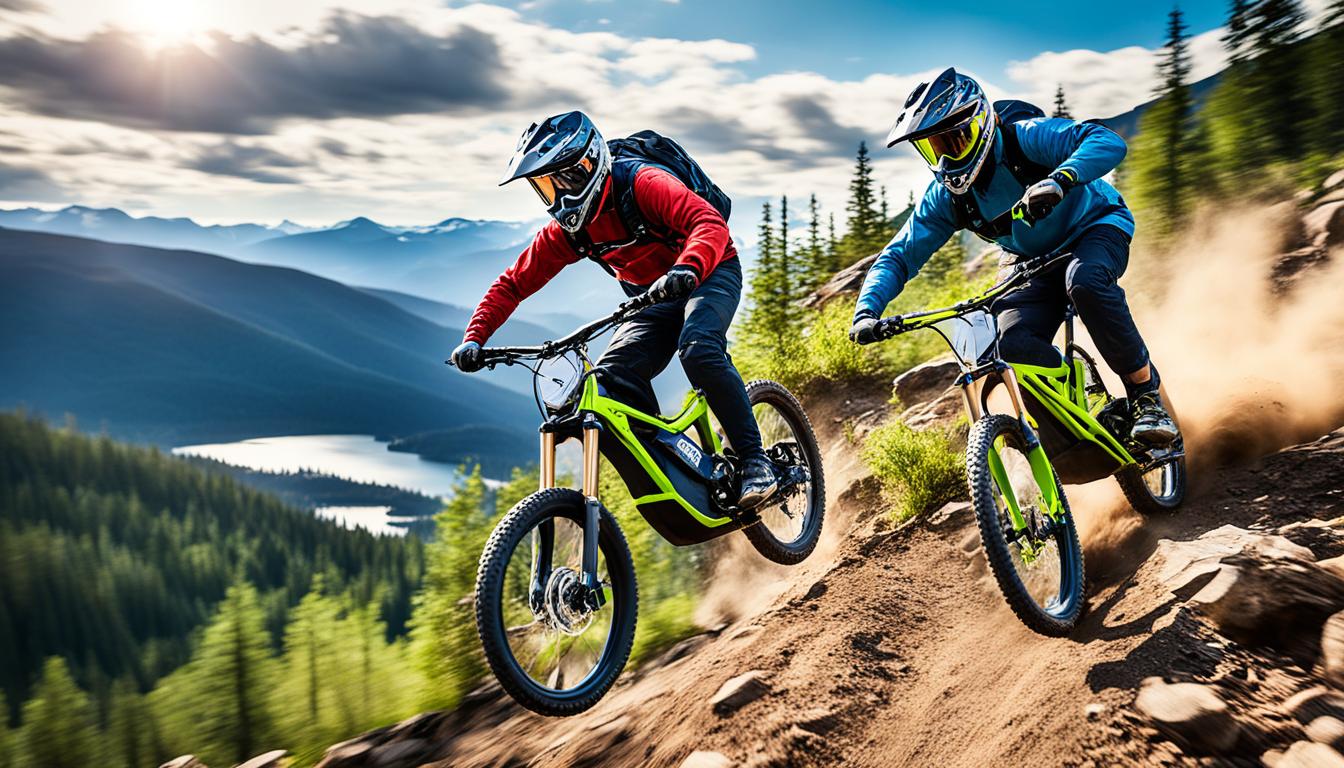Are you a keen mountain biker? Ever thought about how to get the most out of your e-MTB on tough trails? The key is to understand power delivery. Riding an e-MTB mixes human effort with support from the bike’s motor. Mastering this mix is crucial to push your off-road game to the next level.
Picture yourself gliding smoothly over rocks, tackling steep slopes with ease, and navigating sharp turns with sharp precision. Achieving this on technical trails needs careful power management. It’s about using your e-MTB’s power smartly. So, are you prepared to learn how to use power effectively on these trails?
Key Takeaways
- Understand the different power modes (Eco, Tour, Sport, Turbo) and how to balance power and range
- Learn to switch between power modes seamlessly to adapt to changing terrain and conditions
- Develop the ability to read the trail and anticipate your power needs
- Discover techniques for putting the power down efficiently and overcoming technical obstacles
- Master the timing and nuances of your e-MTB’s power delivery to achieve a seamless, intuitive experience
Understanding Power Modes
The motor on an electric mountain bike, or e-MTB, has different power settings. These settings let riders adjust how power is used. They vary from the eco-friendly Eco mode to the energy-packed Turbo mode.
Eco, Tour, Sport, and Turbo Modes
Eco mode uses the least power. This helps the battery last longer and the bike to go further. On the other hand, Turbo mode uses a lot of power for fast rides but drains the battery quickly.
Folks often pick Turbo for its speed, only using lower modes on easy paths or downhill. This range of settings gives riders control over their ride experience.
Balancing Power and Range
For e-MTB riders, knowing how to balance power and battery life is key. Using different power modes smartly can mix speed with lasting power. This way, they can ride tough trails feeling sure and in charge.
The technology in e-MTBs, managing power, plays a huge part. It lets riders have fun while getting the most out of their bike’s power. This balance is what makes these bikes so popular on the trails.
Switching Between Power Modes
Riders can switch the power modes easily while riding. By a button on the dashboard, they change from Turbo for tough sections to Tour or Sport for easy parts. This method helps manage the electric bike’s battery well. It lets riders balance between going far and having a lot of fun.
On-the-Fly Mode Adjustment
With the switch power modes ability, riders can fit the bike’s power to the land and what they’re doing. They can move from Eco, Tour, Sport, to Turbo modes swiftly. This way, they make the most out of the battery, enjoying a thrilling ride at the same time.
Battery Management Systems
Most e-MTBs come with a tool to check the range and battery level. Some bikes go a step further with special battery management systems. These systems adjust the power to get the most out of the battery. With this, riders can pick the best power mode for each part of their journey. Thus, they’re ready to tackle any trail without draining the battery too fast.
The Traction Equation
Using an e-MTB seems easy at first. You choose an electricity boost, start pedaling, and the motor sensors do the math on adding power. Yet, on real trails, things get interesting. Mountain paths change fast, needing you to adjust the e-power. The motor sensors work out your pedaling effort and speed very fast. But they can’t see into the future. They don’t know when you’ll need more power. Riders who are really good with regular bikes can control their effort without thinking. To be as smooth on an e-MTB, you have to get good at understanding the trail. You must predict when you’ll need to use more or less power.
Motor Sensor Calculations
These motor sensors watch how you pedal, changing the power delivery to suit. But they can’t guess what’s ahead on the trail. You have to learn how your e-MTB reacts to different situations. This helps you get better at the traction equation.
Trail Reading and Prediction
Skilled mountain bikers can look at the trail and see what’s coming. They can figure out when they need to push harder based on the path’s upcoming changes. Doing this early stops them from slowing down. They keep moving smoothly and in control. To do the same on an e-MTB, you need to know how your bike and the trail interact. You predict your power needs based on what’s ahead.
Putting the Power Down
On an electric mountain bike (e-MTB), riders want power that feels natural and works smoothly with their own effort. But sometimes, the quick bursts of power needed for off-road rides can confuse the bike’s system. This is especially true when, for instance, riders stop pedaling briefly to adjust their position. The motor might pause, causing a delay when they start pedaling again.
Seamless Power Delivery
Perfectly, the power from the bike would flow steadily or even pick up to help riders tackle tough spots. To achieve this, riders must get to know their e-MTB well. They should learn to control the power it gives, facing challenging grounds with a steady, responsive flow. This skill is key to mastering the power down technique smoothly and efficiently.
Overcoming Terrain Obstacles
It’s vital to get a grip on how the e-MTB’s power works to handle tricky trails and obstacles. Riders need to understand how their bike responds to their movements. Things like how hard they press the pedals or how fast they spin the cranks. This understanding helps them master the bike’s power. It lets them smoothly deal with anything the trails throw their way.
Timing is Everything
Getting the timing of power delivery right is key on an e-MTB. It’s important for riders to understand their motor sensors. They need to learn the dynamics of power response. This includes knowing how much pedal pressure and crank rotation makes the sensors work.
Pedal Pressure and Crank Rotation
On an e-MTB, motor sensors only react to the rider’s pedal pressure and crank rotation. Riders should first learn how these sensors take their inputs. Then, they can ride technical trails with the same freedom as a regular bike once they know how to use the power modes.
Learning Your Bike’s Power Delivery
Start by learning how power delivery works in a safe area. This will be very helpful on the trail. It’s important to know when the motor applies e-MTB power control. This helps riders manage power better in different riding situations.
Managing Power Delivery on Technical Trails
To have fun and go fast on an e-MTB, riders must learn to use the power modes. They need to understand how the modes work with the pedals. This learning happens in a safe, open space, like a park. That way, they can avoid crashes while they practice.
Open Area Practice
In figuring out the motor’s power timing, riders will ride better in tricky spots. They learn about pedal pressure, crank rotation, and how sensors react. This is key to handling power on rugged trails.
Mastering Motor Intricacies
Time in a safe, open place helps riders get used to their e-MTB’s power. It’s about learning how to manage the power for tough trails. This early practice makes them better at handling challenging rides.
Fat Tire Electric Bikes: Conquering the Great Outdoors
Fat tire electric bikes are perfect for those who love adventure off the beaten path. Their wide fat tires help riders stay stable on surfaces like snow, sand, and mud. This stability is key for tackling tough terrains.
Unleashing the Power of Fat Tires
These bikes come with strong motors that make climbing steep hills easier. With the fat tires’ help, riders can go over rough ground with more power. They are a top choice for exploring nature’s challenging parts.
Unmatched Power and Performance
The top models, for example, those from “Frederick Rhodes”, have great brakes and suspension. This means riders can control their bike well, no matter the trail. They can smoothly go through snow, sand, or mud, making these bikes the best for adventures.
Exceptional Control and Handling
Fat tire e-bikes give riders confidence on any rough terrain. Thanks to their advanced parts, like good brakes and suspension, the ride is stable. This lets riders enjoy nature without the worry of losing control.
Stylish and Sustainable Design
These bikes look good and are good for the planet. They are a great choice for those who care about the environment and love the thrill of off-roading. With their eco-friendly features, they are the future of outdoor fun.
Essential Mountain Bike Skills
Most riders start with key skills for staying on the trail safely and riding well. They work on balance, efficiency, and safety. These make the sport more fun by reducing falls and letting you ride more.
Reading the Trail
To get better at biking, you have to read the trail well. Looking ahead and checking the path lets you see what’s coming. This helps avoid trouble, giving you confidence and control.
Balance and Stability
Being in control and steady on your bike is key. It helps you go over obstacles smoothly. Good balance and knowing how to shift your weight make tough trails doable.
Pedal Stroke Efficiency
Making pedal strokes the right way saves your energy. This is important for climbing and getting over big obstacles. It’s a basic skill that will help you do more and take on harder trails.
Learning these skills well is the secret to getting better at mountain biking. They help you have fewer falls, ride longer, and have more fun at the end. By nailing the basics, you set yourself up for a great biking experience.
Advanced Techniques
Once riders master basic mountain biking, they move to advanced skills. These help them ride tricky trails faster and more confidently. They learn to corner and turn quickly, important for not losing speed through turns. Lifting the front wheel over obstacles lets riders clear them without slowing down.
Cornering and Turning
Learning to corner and turn fast is key for mountain bikers. They do this by leaning and shifting their weight. This helps them go through turns more precisely and quickly, which saves time.
Front Wheel Lifts
Riders lift the front wheel to go over obstacles like logs. This technique is tricky but important. It needs control, balance, and the right timing. Doing this well helps riders keep their speed on tough trails.
Technical Climbs
On steep, technical trails, riders need special skills to go up. They must distribute weight right, pedal efficiently, and read the terrain. These skills are critical for climbing difficult inclines.
Riding Drops
Riding off drops and ledges is thrilling but needs advanced skills. Riders must land and manage their weight well. With the right skill, they can navigate these features confidently and smoothly.

